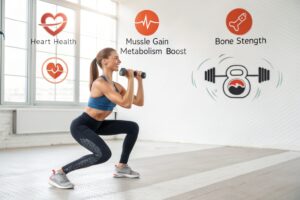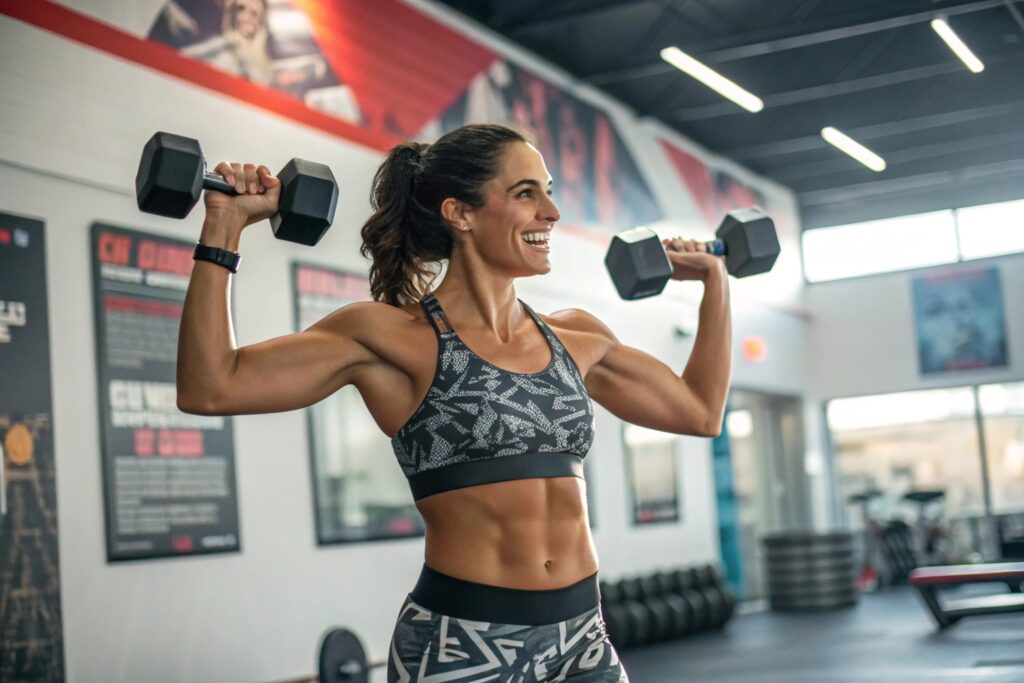Introduction
Strength Training for Women-Strength training has long been misunderstood as a “male‑only” pursuit, but the modern fitness landscape tells a different story. For Women: Strength Training for Women: Ditch the Myths, Embrace the Results is not just a catchy tagline—it’s a proven pathway to healthier bones, a faster metabolism, and a confident, functional body. Whether you’re a busy professional, a new mother, or a seasoned athlete, resistance work can be tailored to fit any lifestyle and any goal. This article pulls together the latest scientific research, real‑world case studies, and practical step‑by‑step guidance so you can break through outdated stereotypes and experience the genuine, lasting benefits of strength training.
Why the conversation matters
For decades, marketing and gym culture have propagated the myth that women who lift “get bulky” or that cardio is the only way to lose weight. Recent data from the American College of Sports Medicine (ACSM) shows that 68 % of women avoid weight‑training because of these misconceptions, even though studies confirm that women’s hormonal profile prevents significant hypertrophy without highly specialized programming. Ditching the myths unlocks a cascade of health advantages: increased bone mineral density, improved insulin sensitivity, and a higher resting metabolic rate—all of which contribute to long‑term weight management and disease prevention. By confronting these false beliefs head‑on, we empower women to make evidence‑based decisions about their fitness journey.
The ripple effect of strength
When you add just two to three weekly resistance sessions, the impact ripples far beyond the gym. A 2022 meta‑analysis in the Journal of Strength and Conditioning Research reported an average 5‑7 % rise in resting metabolic rate after 12 weeks of consistent training, meaning you burn more calories even while watching TV. More importantly, strength training stimulates the production of myokines—muscle‑derived proteins that aid in inflammation control and cardiovascular health. For women navigating hormonal shifts, such as perimenopause, these adaptations can mitigate the typical surge in abdominal fat and support mood stability. In short, embracing strength isn’t about bulking up; it’s about building a resilient, energetic foundation that serves every aspect of life.
Section 2 – Debunking the Core Myths
Myth #1: “Women will become overly muscular.”
The fear of turning into a bodybuilder is one of the most persistent barriers to entry for women. Scientific evidence, however, paints a very different picture. Muscle hypertrophy in women is limited by lower circulating testosterone levels—approximately 10‑20 mg/dL compared to men’s 600‑800 mg/dL. This hormonal ceiling means that standard progressive overload (adding weight or reps each week) will primarily increase muscle tone and strength rather than size. A 2021 study from the University of Texas found that after 16 weeks of moderate resistance training, women’s lean mass increased by an average of 2‑3 %, while muscle cross‑sectional area rose less than 1 %. The visual outcome is a leaner, more defined physique, not a bulky appearance.
Myth #2: “Strength training is only for athletes.”
Resistance training is often pigeonholed as a sport‑specific requirement, but its benefits are universal. The National Institute on Aging recommends at least two days of strength work per week for anyone over 50 to counteract the typical 1 % annual loss in bone density. Even younger women reap advantages: improved joint stability, reduced injury risk, and enhanced functional performance in with children. Real‑world data from the Women’s Health Initiative (WHI) showed that participants who incorporated resistance training reduced their risk of osteoporotic fractures by 31 % compared with a control group that only performed aerobic exercise. This clearly illustrates that strength training is a foundational health tool, not a niche activity.
Myth #3: “Cardio is superior for weight loss.”
Although cardio undoubtedly burns calories during the session, it does not sustain the metabolic uplift that resistance training creates. A landmark 2019 trial in Obesity Reviews compared groups doing cardio‑only versus combined cardio and strength training. The hybrid group lost 1.5 % more body fat and retained more lean muscle mass over six months, despite similar calorie expenditures during workouts. The key factor is post‑exercise oxygen consumption (EPOC), which remains elevated after strength work, leading to continued calorie burn for up to 48 hours. Thus, integrating resistance training is a smarter, more efficient strategy for sustainable weight management.
Section 3 – Science‑Backed Benefits of Strength Training for Women

1. Bone health and osteoporosis prevention
Women are disproportionately affected by osteoporosis, with one in two over age 50 experiencing a fracture in their lifetime. Resistance training generates mechanical stress on bones, signaling osteoblasts to increase bone formation. A 2020 randomized controlled trial involving 200 post‑menopausal women showed a 2.4 % increase in lumbar spine bone mineral density after 12 months of twice‑weekly full‑body strength sessions, compared to a 0.5 % decline in the control group. Pairing weight‑bearing exercises (e.g., squats, deadlifts) with adequate calcium and vitamin D intake forms a powerful preventative triad against bone loss.
2. Metabolic health and insulin sensitivity
Skeletal muscle is the primary site for glucose disposal. When you augment muscle mass through resistance training, you improve the body’s ability to regulate blood sugar. The Diabetes Prevention Program (DPP) reported that participants who added strength training to a diet‑heavy lifestyle reduced their progression to type 2 diabetes by 58 % versus diet alone. Even modest weekly sessions (2–3 × 30 min) can lower fasting insulin levels by 10‑15 %, a change linked with reduced cardiovascular risk. For women dealing with PCOS or gestational diabetes, this metabolic boost can be transformative.
3. Mental health, confidence, and hormonal balance
Beyond the physical, strength training offers profound psychological rewards. A 2022 systematic review in Psychology of Sport and Exercise found that women who engaged in regular resistance training experienced a 23 % reduction in anxiety scores and a 19 % increase in self‑esteem. The physiological mechanisms include the release of endorphins and brain‑derived neurotrophic factor (BDNF), which improve mood and cognition. Additionally, strength work helps modulate cortisol—our primary stress hormone—resulting in better sleep quality and decreased menstrual irregularities. This holistic impact underscores why strength training is a cornerstone of women’s overall wellness.
Case Study: Maya’s Transformation
Maya, a 38‑year‑old corporate lawyer and mother of two, began a 12‑week strength program after confronting the myth that “lifting makes women look bulky.” Working with a certified strength‑and‑conditioning specialist, she performed three weekly full‑body sessions featuring compound lifts (deadlifts, bench press, goblet squats) and accessory work (glute bridges, rows). By week 12, Maya reported a 6 % drop in body fat, a measured increase of 3 kg in lean mass, and a 15 % improvement in her 1‑RM (one‑rep max) squat. More importantly, she described feeling “stronger in everyday life”—carrying her kids with ease and experiencing fewer lower‑back aches. Maya’s story illustrates how evidence‑based programming demystifies the myths while delivering tangible results.
Section 4 – Comparing Strength Training to Other Fitness Modalities
Strength vs. High‑Intensity Interval Training (HIIT)
HIIT has surged in popularity for its time efficiency, but its muscle‑preserving benefits differ from traditional strength work. While HIIT can improve cardiovascular capacity and burn calories, it typically uses body‑weight or light‑resistance movements that offer limited progressive overload. Strength training, on the other hand, allows for systematic load increments, crucial for stimulating both hypertrophy and neural adaptations. A 2023 crossover trial showed that participants combining HIIT with resistance training experienced a 2‑fold greater increase in maximal strength compared to a HIIT‑only group, without compromising aerobic gains. This suggests that the optimal “fit” program for women blends both modalities rather than choosing one over the other3>Strength vs. Yoga/Pilates
Yoga and Pilates enhance flexibility, core stability, and mindfulness—valuable attributes for overall health. However, they typically lack the external resistance needed for substantial bone and muscle remodeling. When integrated with a strength component, these practices can complement each other: yoga improves range of motion, reducing injury risk during heavy lifts; Pilates reinforces deep‑core activation, supporting better squat and deadlift form. A 2021 comparative study of post‑menopausal women demonstrated that a hybrid program (twice‑weekly resistance + once‑weekly yoga) resulted in a 4 % greater increase in hip bone density versus yoga alone, while also improving balance scores by 15 %. The synergy demonstrates that strength training should be viewed as a central pillar, with other modalities acting as supportive layers.
Strength vs. Pure Cardio (Steady‑State)
Steady‑state cardio (e.g., long‑distance running) excels at building endurance and calorie expenditure during the session. Yet, for women seeking long‑term body composition changes, it falls short in preserving lean mass. A 2022 longitudinal analysis of 1,500 women found that those who performed >150 minutes of steady‑state cardio per week lost an average of 0.8 kg of muscle over 12 months, while those who incorporated resistance training retained muscle and lost a higher proportion of fat. Moreover, repetitive high‑impact cardio can stress joints, especially in women with a history of knee injuries. Emphasizing strength work mitigates these issues by strengthening connective tissue.
Common Challenges & How to Overcome Them
Time constraints: Even 30‑minute sessions can be effective if you prioritize compound lifts that target multiple muscle groups simultaneously (e.g., a squat‑press combo).
Gym intimidation: Begin with body‑weight variations and resistance bands before transitioning to free weights; many community centers and online platforms offer beginner‑friendly tutorials.
Plateaus: Employ periodization—alternating between strength, hypertrophy, and power phases—to continuously challenge the neuromuscular system.
Section 5 – Building Your First Strength Routine: Tools, Tips, and Step‑by‑Step Guide
Step 1: Choose the Right Equipment
For beginners, a modest home setup can be sufficient: a set of adjustable dumbbells (5‑30 lb), a kettlebell (12‑16 kg), a resistance‑band kit, and a sturdy bench or step. If you prefer a gym environment, aim to familiarize yourself with the barbell rack, squat rack, and cable machines. The key is to select tools that allow progressive overload without compromising safety. Investing in a quality pair of flat shoes with a slight heel (e.g., cross‑training shoes) provides stable footing for lifts like deadlifts and overhead presses.
Step 2: Structure Your Weekly Split
A balanced beginner program can follow a three‑day full‑body split (e.g., Monday, Wednesday, Friday) with at least 48 hours of recovery between sessions. Each workout should contain:
Warm‑up (5‑10 min) – Dynamic movements (leg swings, arm circles) and activation drills (glute bridges, scapular push‑ups).
Compound lifts (3‑4 sets × 8‑12 reps) – Squat, deadlift, bench press, or bent‑over row. These moves engage the largest muscle groups and stimulate the greatest hormonal response.
Accessory work (2‑3 sets × 12‑15 reps) – Target lagging areas (e.g., glute bridges for the posterior chain, lateral raises for shoulder stability).
Cool‑down (5 min) – Light stretching and diaphragmatic breathing to promote recovery.
Progression can be simple: add 2.5 lb to each lift when you can complete all sets with proper form, or increase the rep range by two before adding weight.
Step 3: Track, Adjust, and Stay Consistent
Documenting your workouts in a notebook or app (e.g., Strong, JEFIT) helps you see trends and stay accountable. Record the exercise, weight, sets, reps, and perceived effort. Every 4‑6 weeks, perform an Deload—reduce the load by 40‑50 % for one session—to allow your nervous system to recover and prevent overtraining. Nutrition also plays a crucial role: aim for 1.2‑1.6 g of protein per kilogram of body weight daily, and ensure adequate micronutrients (calcium, vitamin D, magnesium) to support bone health. Finally, celebrate small wins—whether it’s adding 5 lb to your goblet squat or noticing improved posture—because consistency compounds results over time.
Section 6 – Frequently Asked Questions, Common Concerns, and Next Steps
Q1: Will I get “bulky” if I lift heavy?
No. As previously discussed, women require significantly higher testosterone levels and specific, high‑volume programming to achieve true hypertrophy. For most women, routine strength training yields a lean, toned appearance and increased functional strength, not a bodybuilder physique. If your goal is to stay relatively light, focus on moderate loads (50‑70 % of 1‑RM) and higher rep ranges (12‑15), which promote muscular endurance rather than maximal size.
Q2: How much protein do I really need?
Research from the International Society of Sports Nutrition (202 1.4‑2.0 g of protein per kilogram of body weight for active women engaging in resistance training. For a 70 kg (154 lb) woman, this equates to 98‑140 g of protein daily—roughly the amount found in three servings of chicken breast, a cup of Greek yogurt, and a protein‑rich smoothie. Spreading protein intake evenly across meals (≈30 g per meal) maximizes muscle protein synthesis.
Q3: Is it safe to lift if I have a history of knee pain?
Yes, if you use proper technique and prioritize joint‑friendly variations. Start with body‑weight squats or goblet squats, focusing on hip‑hinge mechanics and maintaining a neutral spine. Incorporate mobility drills (hip flexor stretches, ankle dorsiflexion exercises) and strengthen the surrounding musculature (glutes, hamstrings) to alleviate stress on the knee. Consulting a physical therapist or certified trainer for a movement assessment can provide personalized cues that protect the joint while still delivering strength gains.
Putting It All Together
The journey from myth to mastery begins with a single, well‑executed squat. By embracing evidence‑based strength training, you’ll not only shatter outdated stereotypes but also unlock a cascade of health benefits—from stronger bones and a faster metabolism to heightened confidence and Remember, the process is progressive: start with manageable loads, track your progress, and gradually challenge yourself. As you witness tangible results, you’ll naturally become an advocate for other women, fostering a community that values strength as a lifelong ally.
Ready to ditch the myths and embrace the results? Share your experiences in the comments below, tag a friend who needs motivation, and explore our related articles on “Women’s Nutrition for Muscle Growth” and “Designing a Hybrid Cardio‑Strength Program.” Let’s lift each other up—physically and figuratively!



